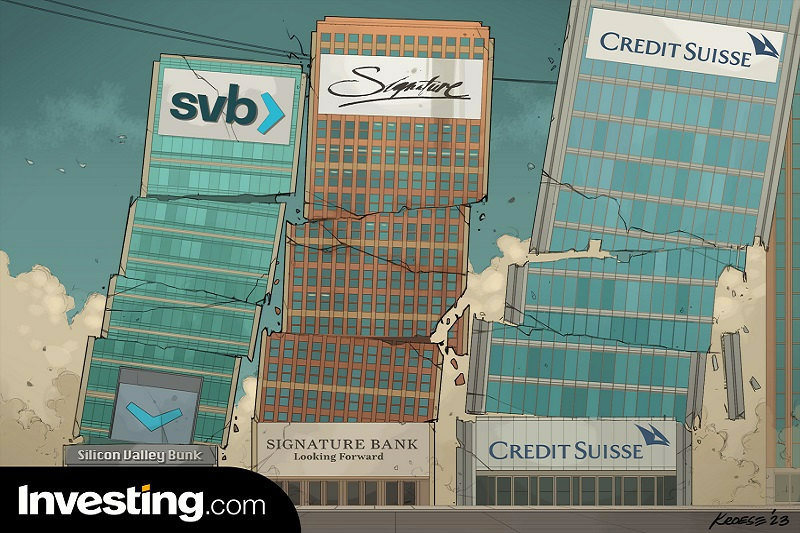By Geoffrey Smith
Investing.com -- The rout of 2023 is turning into a whodunnit without a murder weapon.
One of the big differences between the current wobble in the banking sector and 2008 is that the crucial weakness of banks involved has been on the liability side. It was the deposit runs from Silicon Valley Bank and Signature Bank that exposed the weaknesses in how they managed their assets: these were of good quality, but had to be sold hastily to cover demands for liquidity, thus making paper losses real ones.
That’s a clear contrast with 2008, when the core problem was junk mortgage loans offered to people who had little or no chance of repaying them.
We argued last week that one key reason to think that the financial system will avoid a rerun of 2008 is that there is no class of assets big enough or rotten enough to play the role that subprime credit did then. That is still true today. But if you were forced to finger one asset class take could play that role, it would most likely be commercial real estate.
CRE is a big market – accounting for over $5.6 trillion in outstanding loans, according to Goldman Sachs analysts. Concentration risks are also high. Over half of the total, Goldman says, is owed to banks. Worryingly, it has grown quickly: $725 billion has been thrown at the sector since the middle of 2021, according to the Federal Reserve.
CRE is also a highly leveraged business, that can wipe out equity quickly when the cost of debt rises sharply, as it has done over the last year. Consultancy firm Oxford Economics forecasts that U.K. property prices will fall by 10% for a second straight year in 2023, due largely to changes in interest rates. Euro zone prices will also fall by 10%, after a 3% drop last year, Oxford’s Mark Unsworth reckons.
“CRE is highly interest rate sensitive,” Unsworth wrote in a note to clients. “After a decade of easy money, it now looks exposed, particularly the parts of the market that have used excessive leverage to boost returns, such as private equity.”
MSCI researchers, meanwhile, estimate that some $3.2 trillion of assets were sold over the 11 quarters when the 10-year Treasury bond yield was lower than 2%, a time when it seemed that cheap money would last forever and that yield-hunting was a low-risk strategy.
In the absence of adequate interest rate hedging (as with Silicon Valley Bank) or the ability to exact higher rents, a large amount of those property investments are now underwater. Big names in the sector, such as Brookfield (NYSE:BN) and PIMCO, have already let affiliates default on commercial mortgage-backed securities to cut their losses.
CRE investors aren’t stupid. They know this and they react as you would expect them to – by pulling their money today rather than tomorrow. That exposes their intermediaries – often Real Estate Investment Trusts, or REITs - to acute liquidity risks: office buildings cannot be liquidated quickly, except at a massive discount. Blackstone Real Estate Investment Trust has been rationing redemptions from its wealthy investor base for four months already, precisely to avoid such loss-generating firesales (thoughts and prayers for the University of California, which put in $4 billion at the start of the year).
Indeed, when a market like commercial real estate moves quickly, it is hard to know exactly what anything is worth, because sales volumes dry up. According to Propertyshark.com, Manhattan sales volumes were down 73% on the year in the fourth quarter, while the number of transactions was down by nearly half.
When real prices are hard to come by, lenders have not just the opportunity but also the incentive to fill the data vacuum with flattering valuation assumptions. It is at this point that we reacquaint ourselves with that old favorite from 2008, the ‘hard-to-value asset’ that just gets carried on the books at historic cost, even though no rational person would pay that amount for it anymore.
All of this is playing out at a time when uncertainty over the real estate market is exceptionally high. The pandemic may well have changed working patterns forever, and has certainly accelerated changes in shopping patterns. Mass layoffs at Big Tech and elsewhere are now hurting demand for new office space.
On his last earnings call, Vornado Realty Trust (NYSE:VNO) chief executive Steven Roth poured scorn on landlords who claim they can work their way from around 60% in-person office occupancy back to 90%, noting that far fewer workers head into the office on Fridays post-COVID than was the case pre-COVID.
“I think you have to assume Friday is dead forever,” Roth said.
If an investor can’t be sure how many days there are in a week anymore, then what certainty can he or she attach to more nebulous things like book valuations? For now, perhaps the only thing standing between us and a real crisis is the fact that CRE, unlike subprime, doesn’t represent the intersection of Main Street and Wall Street, which is where most market car crashes happen.
Even so, there is more than enough wrong with the sector to warrant extreme caution in the current weeks.
